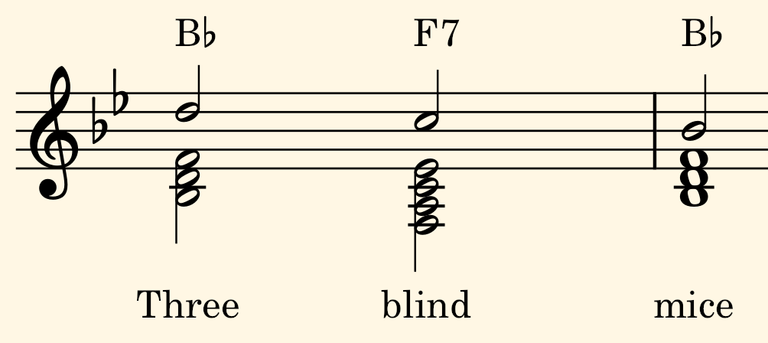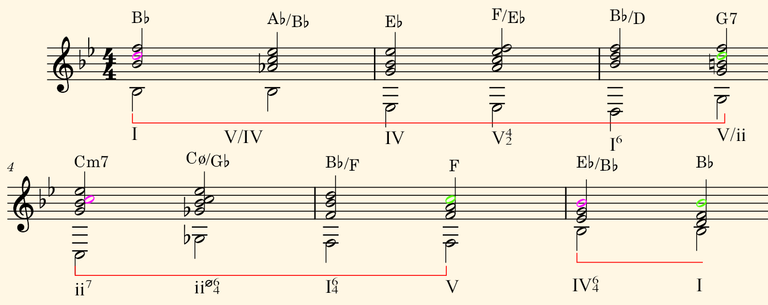The power of Three Blind Mice
There's this idea in music I won't go into the details of because nobody gives a damn, which basically suggests you can boil down any musical harmony to the simple function of 'Three Blind Mice;. Everything else is just decoration.
It's actually quite interesting how true this often is. There are a lot of songs out there which very complex harmony, but the function is simple: A journey from a starting point, with a middle point and an ending: Three. Blind. Mice.
If you look at three blind mice itself, you can easily conceptualise this idea.

On the top you have the melody, which is simply 'Me - Re - Do'. Beneath, you have just two chords. Chord I (Bb), Chord V (F7) and back to chord I again.
That is, in essence, the entire musical journey. The starting point is called the Tonic. This is a place of rest. Home. Stability.
The following music is a journey into increasing instability, as if one was going on an adventure far from home. This is where the 'F7' comes in ('blind').
The F7 is called a dominant chord and basically this is prone to dissonance and instability. When you hear this chord, it does not sound like a place of rest. It feels like it's urging you to go back home.
In fact, any dominant chord is quite open to extreme levels of dissonance. This is the place most jazz musicians have a field day. They can change the F7 to F9, f7(b9), F13, F7(b13), or the ever-mysterious F-alt. It can be substituted by its tritone, it can be extended through a series of secondary dominants and beyond.
This is mumbo jumbo for most readers, fine. But suffice it to say, the dominant chord is the peak of the journey, the climactic moment. What else is left to do but to find a resolution and close the story once and for all - back to the stable chord I ('mice).
It's no different to a classic novel or a movie.
But what about those more complex pieces of music? Well without going too far into the avant garde, let's take a quick look at Elton John's Circle of Life:

There's a whole ton of interesting stuff going on here but no need to concern yourself with that.
Basically, the pink notes determine the beginning of each of the three steps: Three. Blind. Mice. The Green depicts the end of each step. Or simply, the red brackets underneath.
Each pink note is, to no surprise, Me-Re-Do, and the harmony beneath it is I - V - I just like the three blind mice phrase. Everything else is simply the stops you take along the way. These are called Predominants. The thing that comes before the climactic moment.
In total we get Tonic - Predominant - Dominant - Tonic. It's as simple as that.
Jazz music knows this better than anybody else, and most Jazz is almost entirely built around a three-chord system, the ii-V-I.
Chord ii is the predominant
Chord V is the dominant
I is the tonic
Then they just loop it, or shift to another ii-V-I in another key, but serving the same basic function.
Classical music is no exception. Neither is pop or metal or folk or Beijing opera. They all do it. The only reliable exception would likely be some traditional world musics out there, many of which might purely be drums. But even percussive music goes through the same principle.
You start off simple and stable, you build up the rhythms to be complex, even chaotic, and you end by landing back in the safety zone.
The key to making this seemingly dull concept interesting for centuries is to find ways to constantly subvert one's expectations. The very fact that our brains expect a three blind mice motif means we can, for example, go 'Three blind CATS'. That misleading moment is quite pleasing to us. Hearing something fresh can be exciting and beautiful.
In the famous Wagner Opera, Tristan & Isolde, it is a monstrous four hours of that very idea. The piece does not resolve to 'mice' a single time for the entire duration. Anybody attending will undoubtedly feel anxiet-riddled exhaustion by the end, as the music fails to give you a single moment to relax UNTIL the very end, right before the curtains fall, where the piece resolves into the single most majestic, relieving Plagal cadence - which itself is a little subversive, considering a plagal cadence is a IV-I, rather than the V-I 'purist' ending. But it's essentially the same feeling of resolution.
If for some reason the opera failed to end those last few moments, the audience would downright fail to fall asleep that night. But for those who do witness that moment, it's hard to imagine the sensation.
It is this mastery of re-direction which truly makes music such a wonderful art form. Of course, there's no need for it to be so complex. This plays out just the same in a standard pop song. We often expect such a work to go something like C - G - Am - F. But we can just as easily go C - G - Am - Fm.
Why not? It's a tiny difference turning the last chord into a minor chord instead of a major chord, but it's just a bit more refreshingly different.
Anyway, just food for thought.
https://www.reddit.com/r/Music/comments/1jneu9i/the_power_of_three_blind_mice/
The rewards earned on this comment will go directly to the people( @stekene ) sharing the post on Reddit as long as they are registered with @poshtoken. Sign up at https://hiveposh.com. Otherwise, rewards go to the author of the blog post.
its a good information, i used to learn theory to be a better guitar player but now i cant remember anything about that :D
Yeah it's not the most widely used font of knowledge, I'm very aware lol... Like 'triggernometry' - nobody thinks it's useful. But it's SO vital to the battle against AI, to create Unique, human music!
But the song does have a fast bit that doesn't follow the "Moh Re Do" solfa repetition..
What do you mean 'a fast bit?'